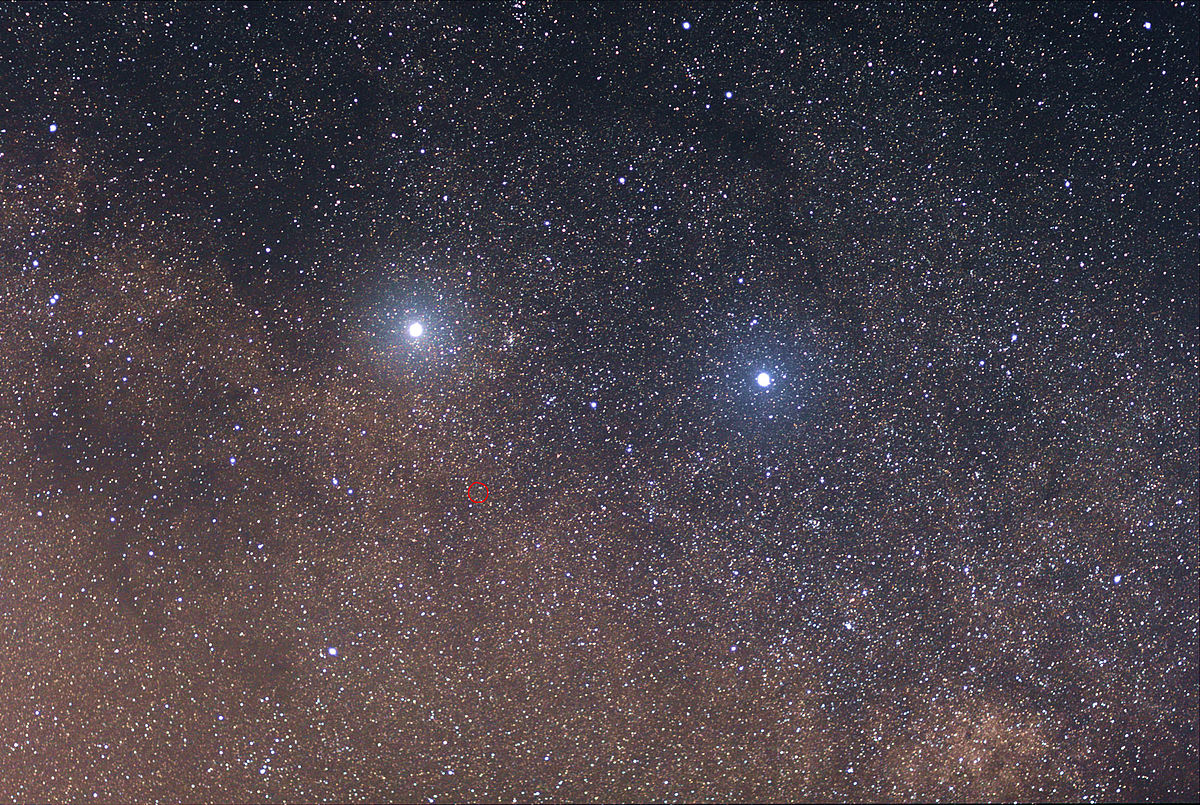The Breakthrough Starshot program aims to cross the immense distances to the nearest star in just decades. Using a high-powered laser to propel a reflective sail technology to relativistic speeds is their mission. The selection of sail material is key to its success as it must be lightweight while being able to withstand acceleration and radiation from the laser. A recent study explores various materials and proposes that core-shell structures—spherical particles composed of two different materials—could be a promising solution.
Continue reading “What Should Light Sails Be Made Out Of?”A Concentrated Beam of Particles and Photons Could Push Us to Proxima Centauri
Getting to Proxima Centauri b will take a lot of new technologies, but there are increasingly exciting reasons to do so. Both public and private efforts have started seriously looking at ways to make it happen, but so far, there has been one significant roadblock to the journey – propulsion. To solve that problem, Christopher Limbach, now a professor at the University of Michigan, received a grant from NASA’s Institute for Advanced Concepts (NIAC) to work on a novel type of beamed propulsion that utilizes both a particle beam and a laser to overcome that technology’s biggest weakness.
Continue reading “A Concentrated Beam of Particles and Photons Could Push Us to Proxima Centauri”What’s the Most Effective Way to Explore our Nearest Stars?

It was 1903 that the Wright brothers made the first successful self-propelled flight. Launching themselves to history, they set the foundations for transatlantic flights, supersonic flight and perhaps even the exploration of the Solar System. Now we are on the precipice of travel among the stars but among the many ideas and theories, what is the ultimate and most effective way to explore our nearest stellar neighbours? After all, there are 10,000 stars within a region of 110 light years from Earth so there are plenty to choose from.
Continue reading “What’s the Most Effective Way to Explore our Nearest Stars?”Starshot … Not? Get a Reality Check on the Search for Alien Civilizations

Fortunately, the real-world search for signs of extraterrestrial civilizations doesn’t have to deal with an alien armada like the one that’s on its way to Earth in “3 Body Problem,” the Netflix streaming series based on Chinese sci-fi author Cixin Liu’s award-winning novels. But the trajectory of the search can have almost as many twists and turns as a curvature-drive trip from the fictional San-Ti star system.
Ground-Based Lasers Could Accelerate Spacecraft to Other Stars

The future of space exploration includes some rather ambitious plans to send missions farther from Earth than ever before. Beyond the current proposals for building infrastructure in cis-lunar space and sending regular crewed missions to the Moon and Mars, there are also plans to send robotic missions to the outer Solar System, to the focal length of our Sun’s gravitational lens, and even to the nearest stars to explore exoplanets. Accomplishing these goals requires next-generation propulsion that can enable high thrust and consistent acceleration.
Focused arrays of lasers – or directed energy (DE) – and lightsails are a means that is being investigated extensively – such as Breakthrough Starshot and Swarming Proxima Centauri. Beyond these proposals, a team from McGill University in Montreal has proposed a new type of directed energy propulsion system for exploring the Solar System. In a recent paper, the team shared the early results of their Laser-Thermal Propulsion (LTP) thruster facility, which suggests that the technology has the potential to provide both high thrust and specific impulse for interstellar missions.
Continue reading “Ground-Based Lasers Could Accelerate Spacecraft to Other Stars”NASA Selects Bold Proposal to “Swarm” Proxima Centauri with Tiny Probes
Humans have dreamed about traveling to other star systems and setting foot on alien worlds for generations. To put it mildly, interstellar exploration is a very daunting task. As we explored in a previous post, it would take between 1000 and 81,000 years for a spacecraft to reach Alpha Centauri (of which Proxima Centauri is considered a companion) using conventional propulsion (or those that are feasible using current technology). On top of that, there are numerous risks when traveling through the interstellar medium (ISM), not all of which are well-understood.
Under the circumstances, gram-scale spacecraft that rely on directed-energy propulsion (aka. lasers) appear to be the only viable option for reaching neighboring stars in this century. Proposed concepts include the Swarming Proxima Centauri, a collaborative effort between Space Initiatives Inc. and the Initiative for Interstellar Studies (i4is) led by Space Initiative’s chief scientist Marshall Eubanks. The concept was recently selected for Phase I development as part of this year’s NASA Innovative Advanced Concepts (NIAC) program.
Continue reading “NASA Selects Bold Proposal to “Swarm” Proxima Centauri with Tiny Probes”Communicating With a Relativistic Spacecraft Gets Pretty Weird

Someday, in the not-too-distant future, humans may send robotic probes to explore nearby star systems. These robot explorers will likely take the form of lightsails and wafercraft (a la Breakthrough Starshot) that will rely on directed energy (lasers) to accelerate to relativistic speeds – aka. a fraction of the speed of light. With that kind of velocity, lightsails and wafercraft could make the journey across interstellar space in a matter of decades instead of centuries (or longer!) Given time, these missions could serve as pathfinders for more ambitious exploration programs involving astronauts.
Of course, any talk of interstellar travel must consider the massive technical challenges this entails. In a recent paper, a team of engineers and astrophysicists considered the effects that relativistic space travel will have on communications. Their results showed that during the cruise phase of the mission (where a spacecraft is traveling close to the speed of light), communications become problematic for one-way and two-way transmissions. This will pose significant challenges for crewed missions but will leave robotic missions largely unaffected.
Continue reading “Communicating With a Relativistic Spacecraft Gets Pretty Weird”Tiny Swarming Spacecraft Could Establish Communications with Proxima Centauri
Achieving interstellar travel has been the dream of countless generations, but the challenges remain monumental. Aside from the vast distances involved, there are also the prohibitive energy requirements and the sheer cost of assembling spacecraft that could survive the trip. Right now, the best bet for achieving an interstellar mission within a reasonable timeframe (i.e., a single person’s lifetime) is to build gram-scale spacecraft paired with lightsails. Using high-power laser arrays, these spacecraft could be accelerated to a fraction of the speed of light (relativistic speeds) and reach nearby stars in a few decades.
There are a handful of major projects, like Breakthrough Starshot, that hope to leverage this technology to create spacecraft that could reach Alpha Centauri in a few decades (instead of centuries). This technology also presents other opportunities, like facilitating communications across interstellar distances. This is the idea recently by a team of researchers led by the Initiative for Interstellar Studies (i4is). In a recent paper, they recommended that a swarm of gram-scale spacecraft could rely on their launch laser to maintain optical communications with Earth.
Continue reading “Tiny Swarming Spacecraft Could Establish Communications with Proxima Centauri”Lightweight Picogram-Scale Probes Could be the Best way to Explore Other Star Systems
Inspiration for space exploration can come from all corners. One of the most inspiring, or terrifying, sources of inspiration for some in space exploration came from computer science expert John von Neumann, who laid out a framework for self-replicating machines in a series of lectures he gave in 1948. Ever since then, scientists and engineers have been debating the advantages, and the perils, of such a system.
However, while technology has indeed advanced a long way since the 1940s, it still seems like we are still a long way from having a fully functional von Neumann machine. That is unless you turn to biology. Even simple biological systems can perform absolutely mind-blowing feats of chemical synthesis. And there are few people in the world today who know that better than George Church. The geneticist from Harvard has been at the forefront of a revolution in the biological sciences over the last 30 years. Now, he’s published a new paper in Astrobiology musing about how biology could aid in creating a pico-scale system that could potentially explore other star systems at next to no cost.
Continue reading “Lightweight Picogram-Scale Probes Could be the Best way to Explore Other Star Systems”Laser-Powered Sails Would be Great for Exploring the Solar System too
Between the exponential growth of the commercial space industry (aka. NewSpace) and missions planned for the Moon in this decade, it’s generally agreed that we are living in the “Space Age 2.0.” Even more ambitious are the proposals to send crewed missions to Mars in the next decade, which would see astronauts traveling beyond the Earth-Moon system for the first time. The challenge this represents has inspired many innovative new ideas for spacecraft, life-support systems, and propulsion.
In particular, missions planners and engineers are investigating Directed Energy (DE) propulsion, where laser arrays are used to accelerate light sails to relativistic speeds (a fraction of the speed of light). In a recent study, a team from UCLA explained how a fleet of tiny probes with light sails could be used to explore the Solar System. These probes would rely on a low-power laser array, thereby being more cost-effective than similar concepts but would be much faster than conventional rockets.
Continue reading “Laser-Powered Sails Would be Great for Exploring the Solar System too”



